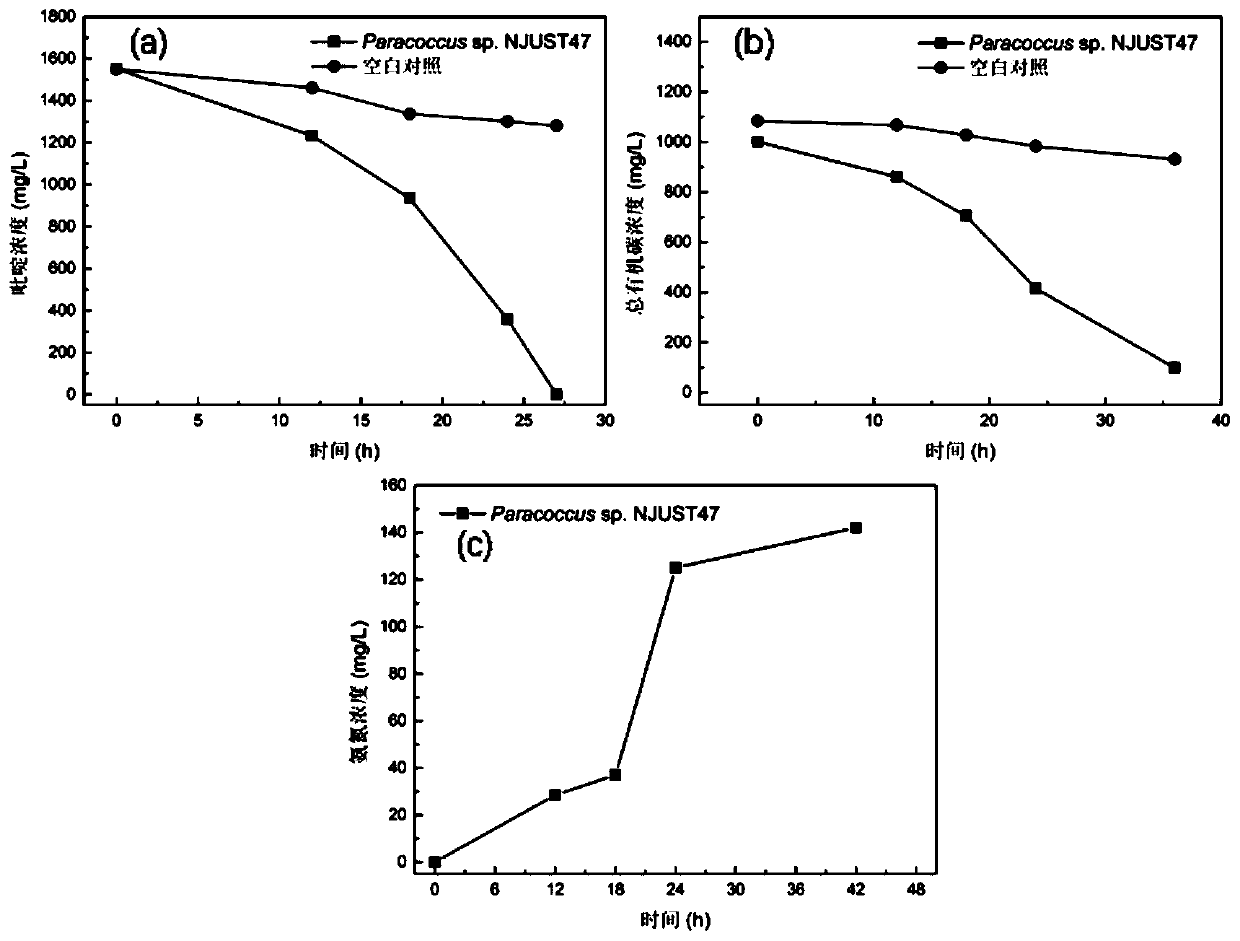Bacterium-algae symbiotic system for enhancing pyridine biodegradation under microaerobic condition
A bacterial-algal symbiosis, pyridine technology, applied in microorganism-based methods, microorganisms, microorganisms, etc., can solve problems such as pyridine pollution, and achieve the effect of effective treatment, promotion of biodegradation, and improvement of sedimentation performance
- Summary
- Abstract
- Description
- Claims
- Application Information
AI Technical Summary
Problems solved by technology
Method used
Image
Examples
Embodiment 1
[0032] Screening, Isolation and Identification of Paracoccus sp.NJUST47
[0033] (1) Isolation of strains
[0034] The existing SBR activated sludge reactor used in the laboratory to treat pyridine wastewater has achieved good results after more than a year of operation. The aerobic granular sludge was taken from the SBR reactor, and after grinding, it was diluted with sterile water to 10 -10 times. To prepare inorganic salt agar solid medium, spread 20 μL of the diluted culture solution on LB agar solid medium containing 500 mg / L pyridine, and place it in a biochemical incubator at 30±2°C for three days. Select the single colonies with obvious differences on the petri dish, and use the method of plate streak separation to carry out purification and culture. After five consecutive purifications, a single strain is obtained and stored on a slant. Prepare the inorganic salt liquid medium containing pyridine and put it into the Erlenmeyer flask, inoculate the pure strain obtai...
Embodiment 2
[0045] Effect of Paracoccus sp. NJUST47 on aerobic biodegradation of pyridine under conventional oxygen supply mode.
[0046] Inoculate the strain Paracoccus sp.NJUST47 into LB medium containing 100 mg / L pyridine, and cultivate it on a shaker at 180 rpm at 30°C to enrich the NJUST47 strain. After the strain enters the logarithmic growth phase (about 48 hours ), centrifuge the obtained bacterium solution for 10 minutes (6000 rpm) to obtain the deposited bacterium, resuspend the sterilized inorganic salt liquid medium, centrifuge, repeat washing three times, and resuspend the bacterium in sterile In the liquid inorganic salt medium, obtain the seed liquid (control OD 600 about 1.7).
[0047] Prepare an inorganic salt liquid medium with 1500mg / L of pyridine as the only carbon and nitrogen source as simulated wastewater, add the above seed liquid to the simulated pyridine wastewater, the inoculum size is 5%, and the temperature is 180 rpm at 30°C. The rotary shaker culture was c...
Embodiment 3
[0050] This example is used to illustrate the cultivation of the bacteria-algae symbiosis system and the process of enhancing pyridine biodegradation.
[0051] (1) Preparation of inoculum: After culturing Chorella sorokiniana FACHB-275 with BG-11 medium for one month, the liquid algae was centrifuged at 8000 rpm for 10 minutes, and then phosphate buffered saline was used to The remaining nutrients were washed away, and the obtained algae sediment was used as the microalgae inoculum after centrifugation again. Inoculate Paracoccus sp.NJUST47 into nutrient broth (NB) containing 100 mg / L pyridine at a concentration of 18 g / L. After cultivating on a shaker for 48 hours, centrifuge the bacterial solution at 6000 rpm. After 10 minutes, the residual nutrients were washed away with phosphate buffer solution, and the bacterial sediment obtained after centrifugation was used as the bacterial inoculum.
[0052] (2) Cultivation of the bacteria-algae symbiosis system: the simulated wastew...
PUM
 Login to View More
Login to View More Abstract
Description
Claims
Application Information
 Login to View More
Login to View More - R&D
- Intellectual Property
- Life Sciences
- Materials
- Tech Scout
- Unparalleled Data Quality
- Higher Quality Content
- 60% Fewer Hallucinations
Browse by: Latest US Patents, China's latest patents, Technical Efficacy Thesaurus, Application Domain, Technology Topic, Popular Technical Reports.
© 2025 PatSnap. All rights reserved.Legal|Privacy policy|Modern Slavery Act Transparency Statement|Sitemap|About US| Contact US: help@patsnap.com



